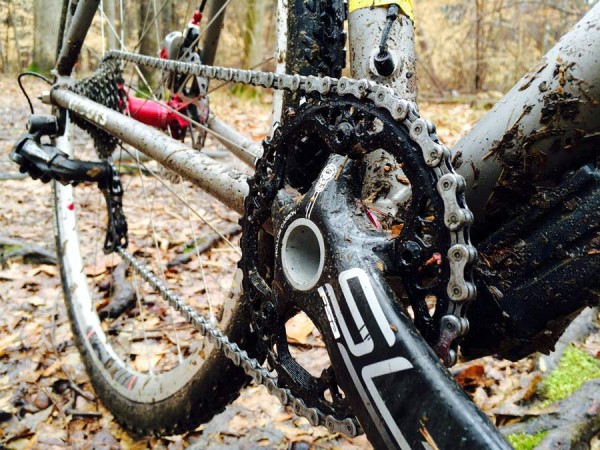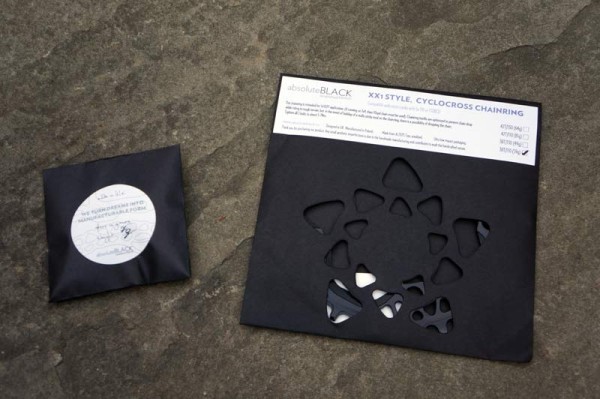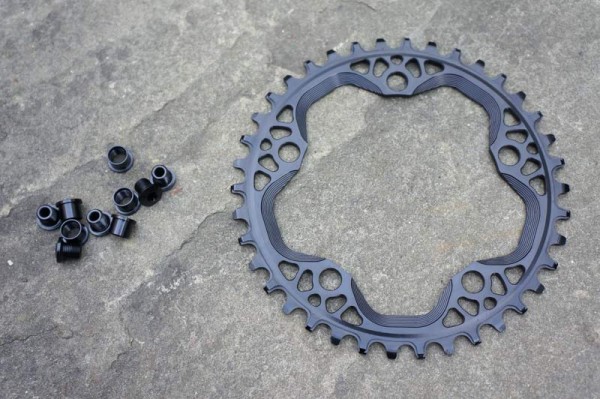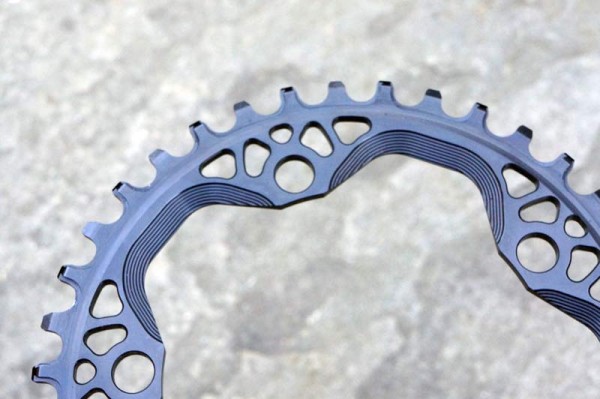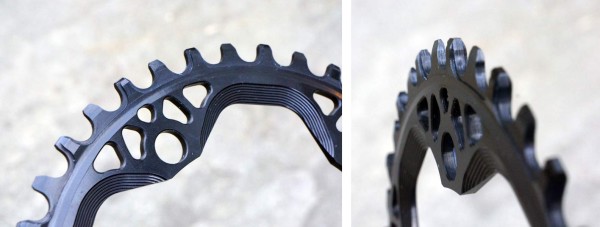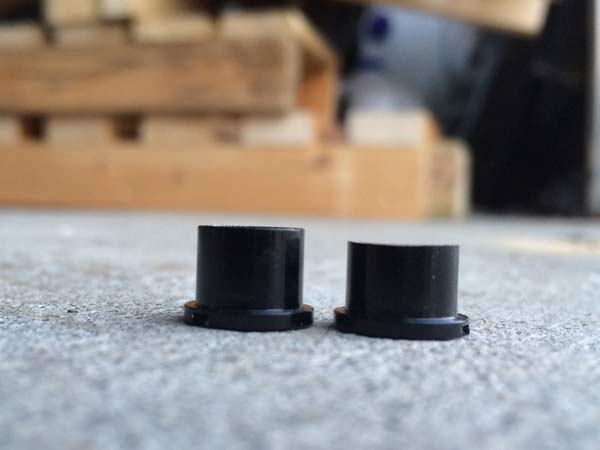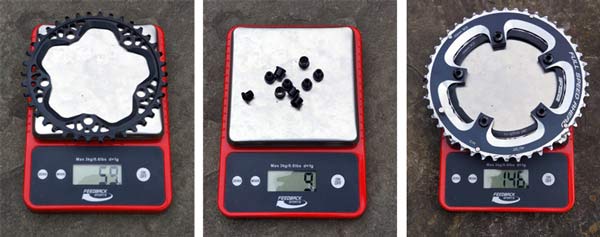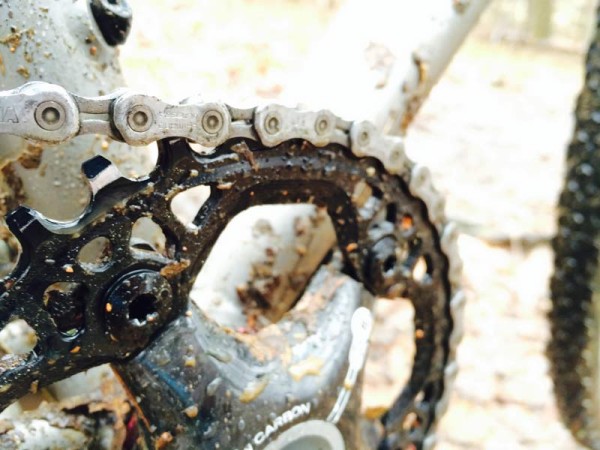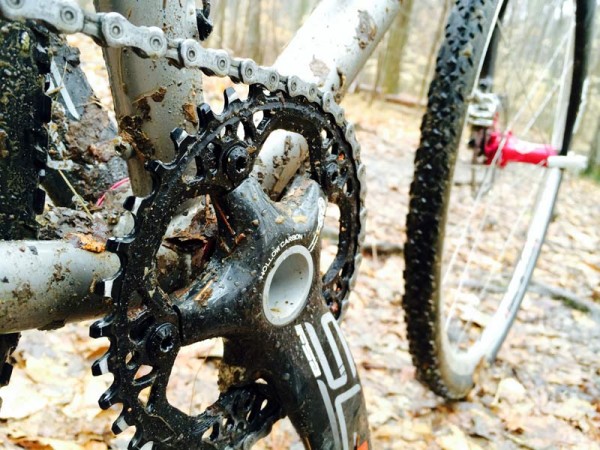Absolute Black’s XX1-style narrow/wide chainring for cyclocross is an appealing option. It’s light, it’s pretty and it uses a common 110BCD mounting pattern. It also has their excellent tooth profiles, which we’ve been pretty happy with across several different bikes and chainrings.
My CX chainring came in at the tail end of last ‘cross season, so it spent beginning of the year getting abused at the last of our local NCCX races. After that, it spent the spring and summer bring ridden around town, through gravel paths and along for some random ‘cross training rides. All the while keeping the chain perfectly intact and rolling smooth.
I installed it on my Moots with an otherwise Ultegra Di2 6770 group, swapping out the double crankset for a standard 110BCD FSA SL-K carbon crankset. This was done mainly for aesthetics, matching the black chainring to a black crankset with more traditionally shaped bolt arms. But also to test the Chris King PFBB with a true BB30 crankset, more on that separately.
The system kept the original Shimano DynaSys 10-speed chain, which has held up admirably well to several years of use on my ‘cross bike. It also kept the rear derailleur set up in it’s stock configuration. Marcin, AB’s founder, strongly recommended that I increase the return spring’s tension, but I wanted to test it as-is first. Here’s how it all went…
Packaging is minimal, with actual weights for each part hand written on the label. The ‘cross chainring is available in both 110 and 130 BCDs with 38 and 42 tooth counts. I tested the 38 110BCD.
The chainrings are available in black or red ano. Marcin also included his Torx chainring bolts, which are sold separately in black only.
AB’s machining detail is fantastic, and the black is a very deep, dark black.
In our many conversations, Marcin’s made it very clear how proud he is of his tooth design. Having ridden both the mountain bike versions and this one for quite some time, I’ll hand it to him – he’s done a great job of keeping the chain on the chainring here and they look good doing it.
The bolts come with longer nuts, which I had to file down to fit the FSA crankset. Stock shown on left, filed one on right. The arms weren’t as thick as some, so the bolts would bottom out on the nut before they’d fully tighten the chainring in place. Note that you file the nut, not the bolt, to solve this problem.
The chainring came in at 59g and the bolts at 9g before any filing. Compared to the standard double (with bolts), that saves 78g just at the crankset. Take away the cable, housing and front derailleur and you’ll save even more…a good tradeoff for a discipline like cyclocross if, like me, you rarely ever used the big ring.
The chainring was thrown onto a drivetrain with a chain that’s seen plenty of use, but it worked smooth and fairly quiet from the outset. A bit of anodization wear showed up within the first two months.
Our NCCX race courses and training grounds tend to cover a lot of grassy hills and flats with shaded sections between the trees that send us rattling over washboards of roots. Add in the occasional low barrier bunny hop or drainage ditch whoops and there’s plenty to test the chain retention qualities of any drivetrain. I’m rather happy to say I didn’t suffer a single chain drop during the entire nine months of testing.
The anodization’s wear also seemed to freeze in time, showing almost no additional wear from the first few months through the end of the test. The chainring bolts remained tight the entire time, too.
When first installed, there’s a bit of noise from from the chain/ring interaction, but it seems to diminish over time. It’s not obnoxious or grating, just present if you’re listening for it. Wind noise at any decent speed drowns it out. I primarily used Squirt lube during the test, which is wax based, so I can’t say if an oilier lube would make it any quieter.
Overall, the Absolute Black CX ring worked flawlessly and I’d recommend it highly. Retail is $74 to $83 depending on size, and chainring bolts are $16.
As for size selection, some folks might miss the 40t intermediate ring. One way to figure out what you need is to ride in your current small chainring (probably a 34 or 39) and see where you’re spending your time on the cassette. Then pick the chainring size that’ll put you closer to the top 2/3 of the cassette during most riding. That reduces chain wear a bit and keeps you out of the less efficient 11t cog in most situations. That’s what we’ve done and it seems to work well while leaving a bit at the top end for straightaway sprints.
NOTE: About the derailleur return spring tension. Marcin says SRAM’s road rear derailleurs have a higher spring tension and should work just fine out of the box. He recommends increasing the spring tension on Shimano road rear derailleurs (this video shows how). He also recommends getting the chain length correct, setting it up with the chain wrapped around the largest cog and chainring (not through the derailleur) then adding two links to the total length. Lastly, a short cage rear mech is recommended. As mentioned, I didn’t mess with my rear derailleur at all and it worked just fine, but if you’re dropping your chain, this could be the solution. All of the set up tips are available on this product’s page on his website.
